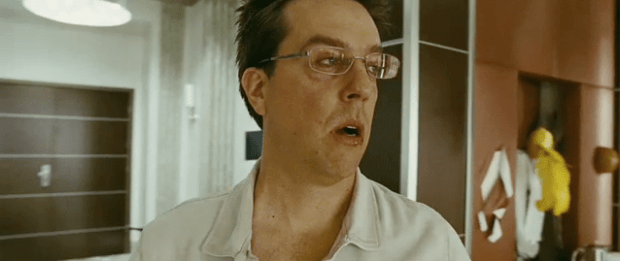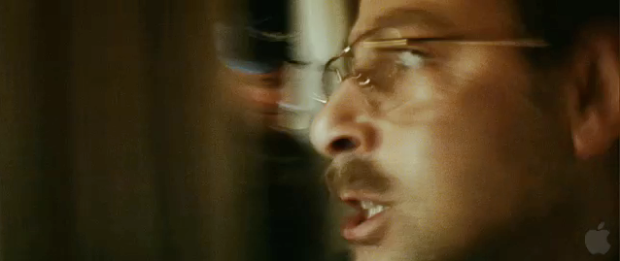If there is one stylistic technique that has reached a point of saturation in Hollywood, then it must surely be the Snorricam, otherwise known as the “reverse steadicam” or the “chestcam.” I would go so far as to suggest that it may even qualify as the technique of the decade. (Ok, that may be an overstatement).
It is normally used sparingly, limited to one or two uses in a film for a few seconds at a time. The Snorricam presents a reverse point-of-view shot, which positions the camera close to the actor’s face and is, most crucially, connected to the actor’s body so it responds to the actor’s actual movement. As a camera technique it has not been limited to uses in particular genres; much like the Steadicam, it has been successfully used in disparate genres, from horror films to romantic comedies. Unlike the Steadicam, though, the Snorricam is a plainly evident and rather pronounced camera technique.
The history of the technique is vague: a Google search results in a number of websites that provide DIY instructions for a home-made chestcam, but very few articles on the technique itself and its history in the movies. Modern use stems from a contraption devised by Einar Snorri Einarsson and Eiður Snorri Eysteinsson, the creative team who work under the name The Snorri Bros., though they are not actually related. According to the pair’s website, the Snorricam was created for a music video “years ago for an all girl punk band. It has since become world famous.” Indeed it has, but why have so many films of the aughts turned to this technique?
Its diffusion in contemporary film and television is certainly owed to the Snorri Bros., but the technique itself is not new. Versions of the mounted camera appear in John Frankenheimer’s loopy Seconds and Martin Scorsese’s breakout film Mean Streets. Both films use it to convey the drunken disorientation of the main characters, which also characterizes the way it has been used in more recent films, such as Requiem for a Dream (more on this film a little later). The intervening decades proved to be unremarkable for this technique, perhaps overshadowed by the far more popular Steadicam, which came to prominence with Bound for Glory and Rocky in the mid-70s. I haven’t been able to find any notable uses of the chestcam in the 80s and 90s outside of Jacob’s Ladder and Malcolm X. Were characters in the 80s not getting drunk, dashing around in a disoriented way? Hardly. Were filmmakers not interested point-of-view shots to give some sense of character psychology? I’m pretty sure they were. So, how did this nifty device not gain traction? Well, on a purely functional level, the apparatus had not yet been refined, so weight and mobility could have been a problem. It is also a fairly disruptive technique, and by that I mean it can be disorienting for the viewer — purposely so, I suppose. So, there is good reason to believe that its design is a bit radical, especially in conservative filmmaking circles.
So, how can we explain the resurgence of the Snorricam in the latter part of this decade? It might be productive to look to Darren Aronofsky’s extensive use of the device in Requiem for a Dream and Pi. On its own, Requiem has become a film student’s film, quotable not so much for its dialogue but for its dizzying visual and sound style. Its stylistic palette even became fodder for The Simpsons. Out of the various techniques Aronofsky used to convey the troubled (and troubling) lives of his characters, the chestcam shots are distinctive for two reasons. First, he holds on the shots for some time, giving the impression that the technique is actually doing something more than providing a momentary visual gimmick. Second, the shots are not mere manifestations of subjective drunkenness, but instead suggest an out-of-body disassociativeness, which are neither purely omniscient nor particularly subjective.
The chestcam appears three times in the film: when Tyrone (Marlon Wayans) flees the gang murder scene, when Marion (Jennifer Connolly) leaves the scene of her first trick, and during one of Sara’s (Ellen Burstyn) paranoid delusions. Marion’s sequence is arguably the most visceral, lasting for over a minute. Aronofsky uses two different camera rigs, one in front and one behind her, to capture her walk from the john’s apartment, down an elevator and outside into the rain where she throws up onto the lens. Overall, the dizzying quality of the chestcam works well in the film mainly because it feels connected to the other overly-stylized elements.

In 2008 and 2009, the chestcam made cameos in The Hangover, Slumdog Millionaire, Rock’n’Rolla, District 9, The Lovely Bones, and Orphan among others. It has found favor among filmmakers like Spike Lee, who has used it in Malcolm X, The 25th Hour and Inside Man. It has even found its way onto television shows like House and CSI. Similarly, the taxi cab sequence in Zodiac accomplishes the same effect when the camera is virtually mounted to the moves of the car. The camera is locked to the CG taxi in a way that is slightly disorienting. The camera moves are too perfect, too still, which makes it all the more eerie.
The technique certainly calls attention to itself, which is perhaps why it is used so briefly. I’m not entirely convinced that it’s an effective technique even though it seems to be the go-to device for contemporary directors looking to add a sense of distorted subjectivity to a particular sequence. Peter Jackson recently spoke to Ain’t it Cool News about its use in The Lovely Bones, where he opted to have Stanley Tucci carry a small camera in his own hands, pointed at his face, while running through the house in one of the film’s climactic scenes. But I’m afraid that by this point it’s reached a point of real saturation, where it’s no longer as effective at creating the needed sense of urgency or “raw” movement. While not quite a gimmick, the Snorricam reminds me of how the slow Steadicam creep-in became a de-facto horror film convention after John Carpenter used it to such great effect in Halloween.
When used in an otherwise plainly shot film, the chestcam feels out of place. By this point it’s become a standard option in a director’s bag of tricks. Directors seem to be working off of each other here, borrowing the device to convey similar points. There are other ways of portraying interior states of mind, but this one seems to be the device du jour.


I remember the use of this technique in both Malcolm X and in Inside Man. I never really understood its use. Lee also uses this in Summer of Sam, when they intro Bobby, the John Lennon-look alike. I did not know that this technique or camera had a specific shot, but it stands to reason that most shots/techniques in filmmaking are named, usally after the guy that pioneered it.
Interestingly, what do you think about the reverse-dolly zoom, if I am naming that correctly? I remember it vividly in Jaws–I think Spielberg got that shot spot on to encompass the draining emotion of the shark attack and I think, as with the Snorricam, it has either been oversued, or not used to prominent effect. The film that comes to mind is Sam Raimi’s The Quick and The Dead, where in addition to using that technique, he also had the camera twisting in dizzying angles. I don’t feel the constant usage of this type of shot was effective at all–seemed just like something to do.
Then again, how much of film is like that?
Hi Rick — the “dolly zoom” is certainly another technique that found favor among filmmakers after Hitchcock innovated its use for Vertigo. It’s probably more useful in certain instances, since it can be employed with a degree of subtlety. My interest in the Snorricam is definitely motivated by the fact that in such a short time filmmakers have turned to it in a variety of genres…yet utilize it to convey the same general effect. Strangely, it’s become so popular that a YouTube search lists at least a dozen DIY versions, which is funny.
Nothing to add except thanks! I love your breakdown of industry tropes. It is illuminating for me, someone interested in movies but not actively studying or making them. You say you are busy, but I don’t mind the shorter posts at all. Still very informative. I would read these regularly.
Check out ‘The Last Laugh’ http://www.youtube.com/watch?v=KM5nJpN7Wdo&feature=related 3:10.
I’m doing my dissertation on similar camera techniques, and this looks like it could have been the earliest influence. What do you think?
You MUST check out the use of the snorricam in the austrian film Angst by Gerald Kargl, released in 1983. It’s a rotating snorricam, it’s incredible. It’s used quite a lot in the film. Here’s an extract : http://www.youtube.com/watch?v=QQD8ifleZ3M
The “action” of the video I posted above starts at 1:40.
You neglected to mention the reverse foreground-background principle. Usually in the real world we experience a stationary background, where objects (or subjects, rather) move in the foreground. When you reverse this, as the Snorricam does, it is automatically trippy to a human. Other shots accomplish the same effect, such as mounting a camera to a moving object like a train or boat or plane, where part of said vehicle is in the foreground. One of the first narratives ever, The Great Train Robbery (1903), utilized this technique with a train.